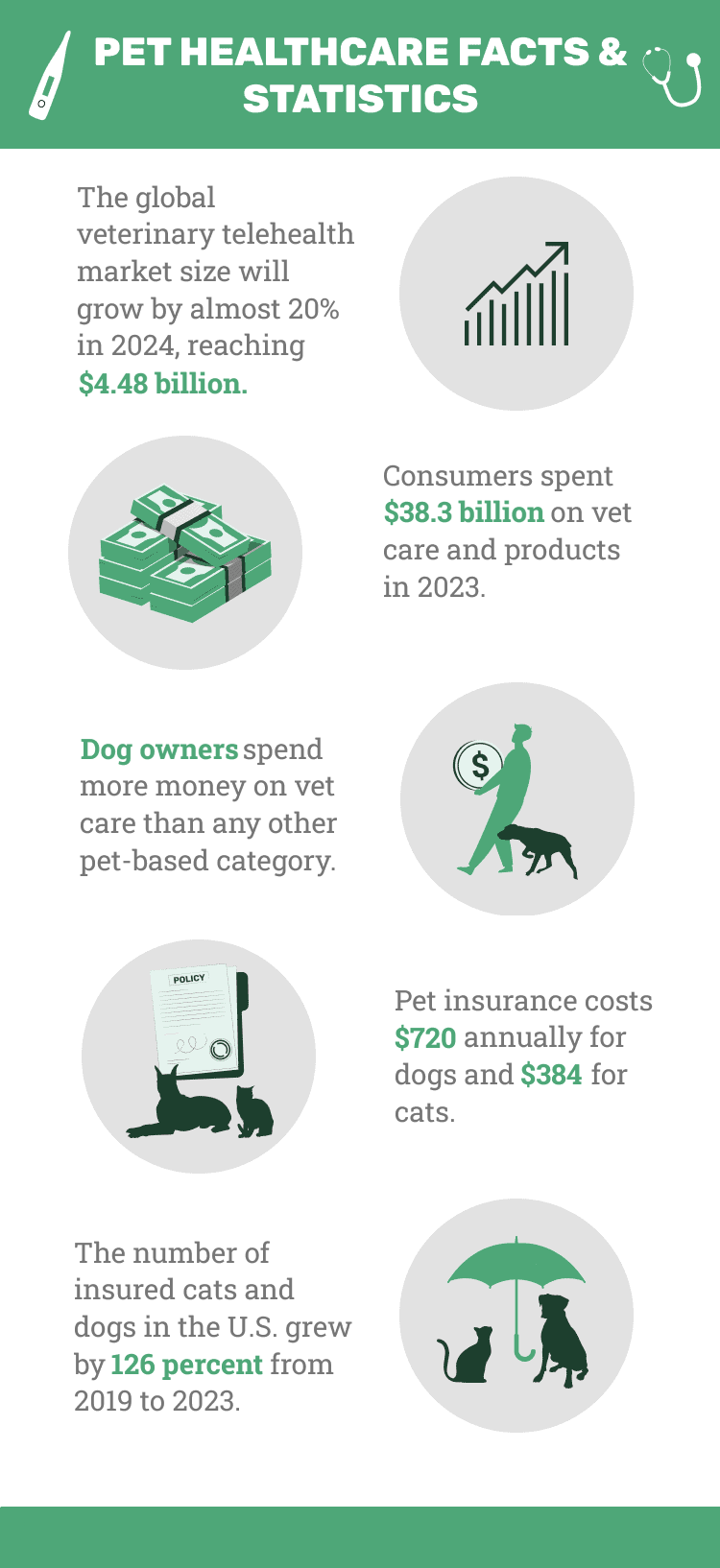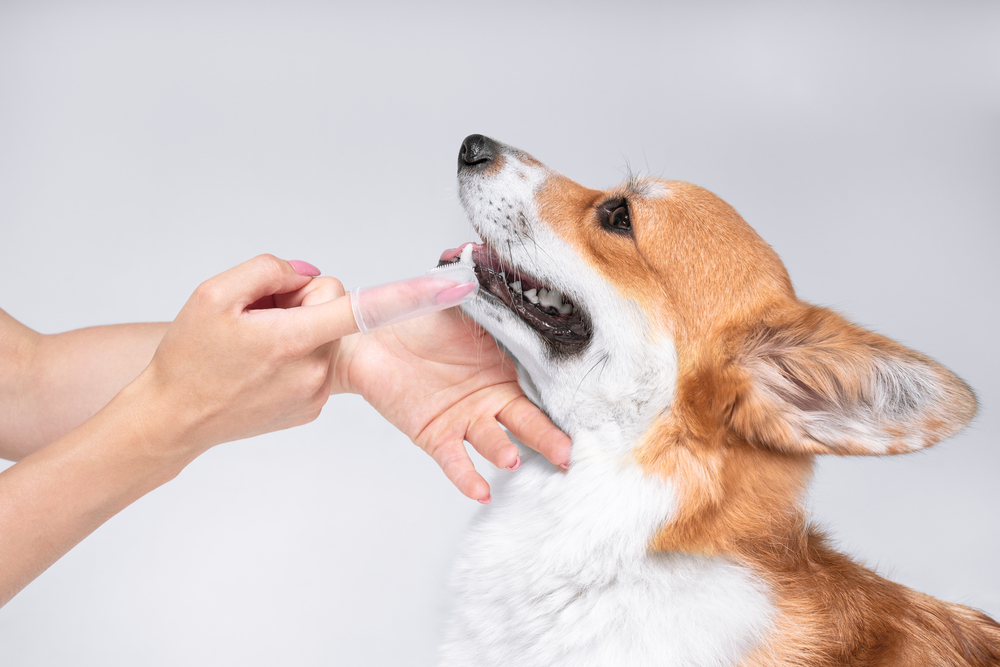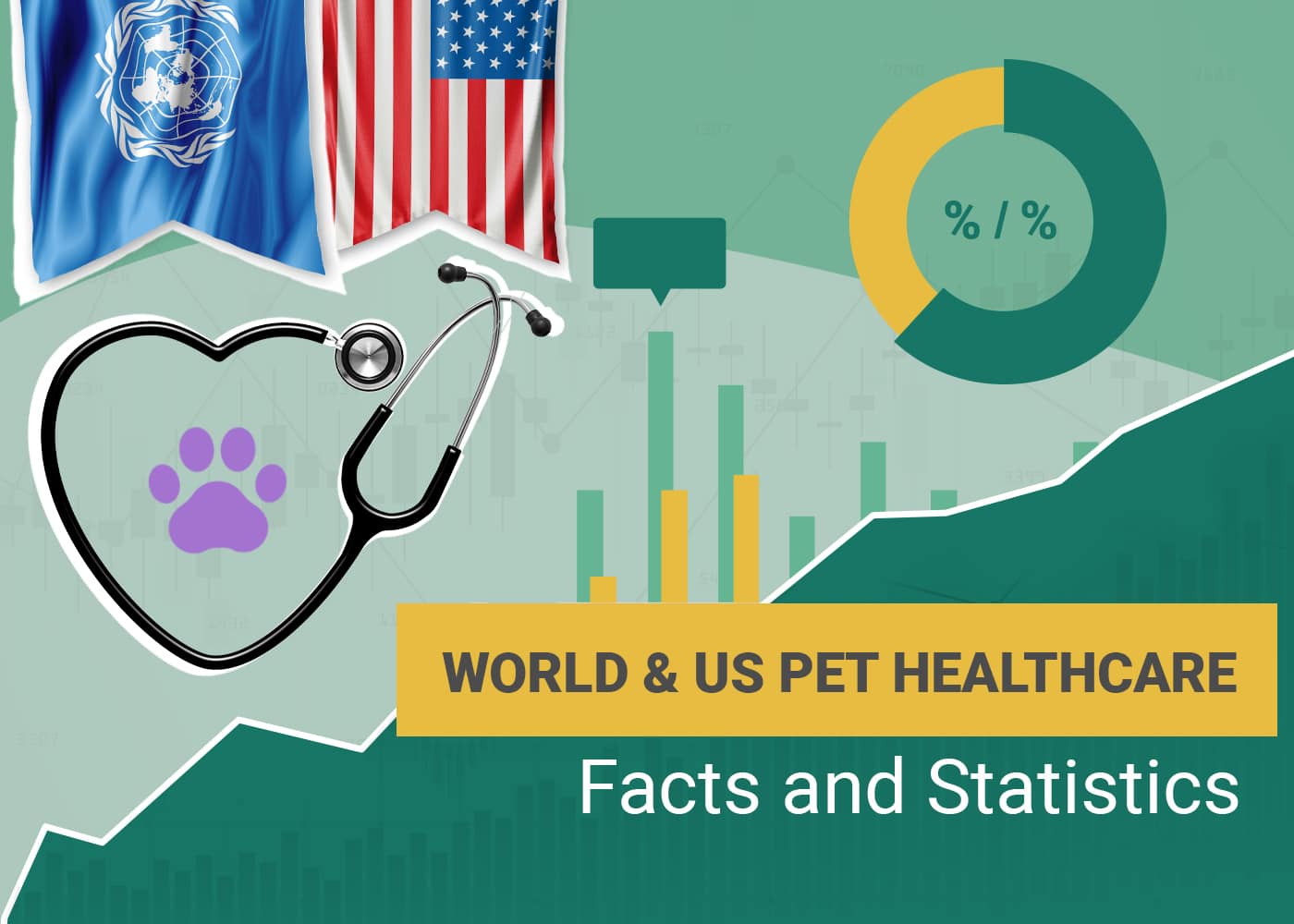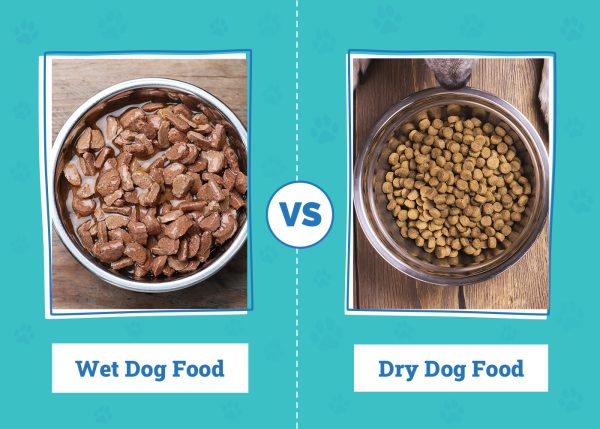In this article
View 3 More +Note: This article’s statistics come from third-party sources and do not represent the opinions of this website.
With more people owning and embracing pets as vital parts of the modern household, the pet healthcare industry has grown significantly in recent years.
Technology is advancing, and despite rising costs continuing into this year, products and services are becoming more diverse, accessible, and effective. In this look at 12 pet healthcare statistics, we’ll explore how today’s trends impact our pets and raise the standards.

The 12 Pet Health Care Statistics
- Skin allergies were the most common health claim for dogs, and intestinal upset was the most common for cats in 2023.
- Three-quarters of pet owners have to wait less than a week to receive vet care.
- Nearly 30% of pet owners don’t use heartworm prevention medicine.
- The global veterinary telehealth market size will grow by almost 20% in 2024, reaching $4.48 billion.
- Consumers spent $38.3 billion on vet care and products in 2023.
- Routine vet visits cost an average of $250 for dogs and $198 for cats in 2022.
- Veterinary care costs increased by 6.4% from June 2023 to June 2024.
- Dog owners spend more money on vet care than any other pet-based category.
- Over 30% of pet owners avoid taking pets to the vet due to the expense.
- Pet insurance costs $720 annually for dogs and $384 for cats.
- The number of insured cats and dogs in the U.S. grew by 126 percent from 2019 to 2023.
- Over 41% of Gen Z pet owners have pet insurance.

Veterinary Care Statistics
1. Skin allergies were the most common health claim for dogs, and intestinal upset was the most common for cats in 2023.
(Nationwide)
Nationwide Insurance handled over 1.5 million pet insurance claims in 2023. Over 410,500 were for canine skin allergies, representing roughly 20% of dog-related claims. Behind it, diarrhea/intestinal upset and ear infections were the second and third most common claims.
Diarrhea and intestinal upset led to the list of top cat ailments in 2023. Urinary tract disease and kidney failure took the second and third spots. Dental disease, arthritis, and urinary tract infections also made the top ten lists of most common claims for both animals.

2. Three-quarters of pet owners have to wait less than a week to receive vet care.
(AVMA)
While visiting the vet can be inconvenient, availability is rarely a reason owners can use to delay setting an appointment. According to the AVMA’s 2023 Pet Owner Attitude Survey, 76% of owners can book vet visits within one week, with 60% only needing to wait 1–3 days.
Emergency visits were similarly expedient since 78% of pets needing urgent help waited less than 2 hours to receive care. Nearly half waited less than an hour.
3. Nearly 30% of pet owners don’t use heartworm prevention medicine.
(Banfield)
Despite the increased priority pet owners are placing on their pets’ welfare, misconceptions leave many pets at unnecessary risk of common threats. For example, Banfield Pet Hospital reports that nearly 30% of dog and cat owners don’t use heartworm prevention, and 40% say they think it’s unnecessary.
The logic flies in the face of the increasing heartworm threat in America. Over 50% of owners skip year-round protection, and 41% believe it’s only a risk during certain seasons. Yet, vets emphasize that it is a year-round risk, especially as global warming keeps mosquitoes active in more places.
Though some states have seen heartworm declines, most have seen the issue increase. Delaware experienced a nearly 300% jump in heartworm cases in 2023. In the past five years, cat cases have increased by 47%.
4. The global veterinary telehealth market size will grow by almost 20% in 2024, reaching $4.48 billion.
(The Business Research Company)
Gen Z’s approach to pet healthcare affects how many owners interface with veterinary experts. The tech-innate generation is leveraging convenient online communication options that an expanding vet telehealth market offers.
The vet telehealth market will reach $4.48 billion in 2024, up from 3.74 billion the prior year. Experts predict the market will grow to $8.99 billion at an impressive compound annual growth rate of 19 percent.


Cost of Care Statistics
5. Consumers spent $38.3 billion on vet care and products in 2023.
(APPA)
Thanks to inflation, longer pet lifespans, and a steadily growing devotion to health care and quality of life, owners spend more on veterinary products and services than ever. In 2023, American consumers spent $38.3 billion on areas like routine check-ups, surgeries, and medications.
Sales in this category increased 6.7% over 2022’s $35.9 billion, continuing a steady YoY increase. Veterinary care spending has jumped roughly 111% since 2018, and experts predict it will eclipse $39 billion in 2024.
6. Routine vet visits cost an average of $250 for dogs and $198 for cats in 2022.
(III)
Veterinary visits are among the pricier expenses pet owners face annually. According to the APPA, routine vet visits cost dog owners an average of $250 yearly, while cat owners spend $198.
The 2022–2023 numbers represented a slight increase from the previous year’s survey, which reported $242 for dogs and $178 for cats. Routine visits still paled in comparison to surgical vet visit costs, which ran annual averages of $472 for dogs and $232 for cats.
7. Veterinary care costs increased by 6.4% from June 2023 to June 2024 (and over 60% in the past decade).
(Bureau of Labor Statistics)
Vet care costs are on a steady upward path, rising 6.4% from June 2023 to June 2024. It was the highest increase of any pet-related expense in that period by a wide margin, the second being pet services such as grooming, boarding, and training at a 6.3% jump.
Services like these far outweigh any other pet-related expenses, and the next highest increase is the purchase of pets, supplies, and accessories. While a 6.4% increase is significant, the rising costs of veterinary services over the past decade are even more eye-opening.
The New York Times shows that veterinary care services have increased in price by more than 60% since April 2014. This increase is nearly double the rate of all items in the Consumer Price Index.

8. Dog owners spend more money on vet care than any other pet-based category.
(Bureau of Labor Statistics)
Health is a paramount concern for pet owners, so much so that they often allot more effort toward veterinary care than most categories. Dog owners spend more than anyone, with 31% of their annual expenditures going to the vet. Behind that were dog products and food, each accounting for 28% of the dog owner’s budget.
By contrast, cat owners spent 26% of their budget on veterinary care, making it only the third-highest expenditure after products (39%) and food (31%).
The difference confirms that dog owners spend more than cat owners on vet care than any other category. For instance, the AVMA’s 2022 Pet Ownership and Demographics Sourcebook reports that while annual spending for food only differed by $29 between the groups, dog owners spent an average of $114 more on vet care than cat owners.
9. Over 30% of pet owners avoid taking pets to the vet due to the expense.
(MarketWatch)
Vet costs are becoming insurmountable for many owners, causing some pets to go without crucial care. According to a 2024 MarketWatch survey, over 30% of owners avoided the vet to prevent an expensive bill.
Even among those with insurance, 22% avoided the vet due to cost. Nearly 29% of all owners couldn’t pay for emergency care, and sadly, roughly 16% have even lost a pet because they couldn’t afford care.

Pet Health Insurance Statistics
10. Pet insurance costs $720 annually for dogs and $384 for cats.
(MarketWatch)
Pet insurance is significantly more expensive for dogs, with an average cost of $720, nearly double the amount cat owners pay for their pets. Overall, pet insurance costs owners roughly $46 per month.
Owners in Connecticut pay the most, with monthly averages of $65 for dogs and $43 for cats. Meanwhile, Louisiana and Alabama pay some of the lowest premiums at $47 monthly for dogs and $27 for cats.

11. The number of insured cats and dogs in the U.S. grew by 126 percent from 2019 to 2023.
(NAPHIA)
The number of cats and dogs getting health insurance coverage has grown steadily in recent years, reaching nearly 5.7 million in 2023. While that only accounts for roughly 5% of the pet population, the YoY increase rate is impressive.
From 2022 to 2023, the number of dogs and cats with insurance jumped 17.1%, with the greatest boost in the last five years being 2021’s 28% increase in insured pets. Since 2019, insured pet numbers have increased overall by an astounding 125.6%, with insured cats showing the most significant growth at over 190% in that same period.
12. Over 41% of Gen Z pet owners have pet insurance.
(MarketWatch)
The astonishing growth in the pet insurance industry is primarily thanks to younger groups taking ownership more seriously than previous generations. While only 2.5% of baby boomers have pet insurance, each successive generation is likelier to have pet insurance than the previous one.
Nearly 13% of Gen Xers and 30.4% of millennials have insurance, while Gen Z owners lead all with the highest rate of insured pets. Over 41% have pet insurance, roughly 16 times the rate of baby boomers.


Frequently Asked Questions About Pet Health Care
What Kind of Healthcare Can My Pet Receive Remotely?
Telehealth is becoming a crucial convenience for pet owners who don’t live close to a vet or can’t afford an in-person visit for minor health issues. Online vets can quickly help clients determine the severity of the problems, offer pointers to alleviate signs, and provide general advice.
In most states, televets are limited to providing advice and triage. Remote vets cannot offer diagnoses, write prescriptions, or provide treatment unless they have a veterinarian-client-patient relationship (VCPR) established through an in-person visit.
However, the laws are changing, and a handful of states now allow vets to establish a VCPR online or over the phone to expand their offerings.
How Does Pet Insurance Work?
Pet insurance is similar to health insurance in that it significantly reduces your out-of-pocket expenses. You pay a monthly premium, and if your pet suffers an illness or injury covered under your plan, your insurer pays a portion (or all) of the cost.
Standard considerations such as your pet’s age and health status, coverage limits, and deductibles determine your premiums. Unlike health insurance companies, pet insurers ask the owner to pay for covered vet services upfront. After you submit a claim, your insurer will approve it and reimburse you.
You pick your reimbursement rate, which may range from 60%–100%, depending on the company. As you might expect, higher reimbursement rates also mean higher premiums. Since you pay the vet, you don’t have to worry about them being “in-network.” Any licensed vet can perform the necessary work without affecting your right to reimbursement.
What Is the Most Common Pet Healthcare Concern?
Cats and dogs have numerous species and breed-specific health concerns pet parents must watch for throughout their pets’ lives, but few are as consistent as dental issues. According to Banfield Pet Hospital, the largest veterinary hospital network in America, nearly three-quarters of all dogs and two-thirds of cats seen at its locations had dental diagnoses, highlighting the importance of daily brushing. (Banfield Pet Hospital)


Conclusion
Pet healthcare is rapidly changing as technologies emerge, capabilities improve, and the veterinary industry expands its services. New challenges meet novel solutions, with opportunities like televets and insurance making care accessible for owners from all walks of life.
As we prioritize our animals more and more, the pet healthcare industry will only continue to evolve, helping us give our pets the best quality of life possible.



















